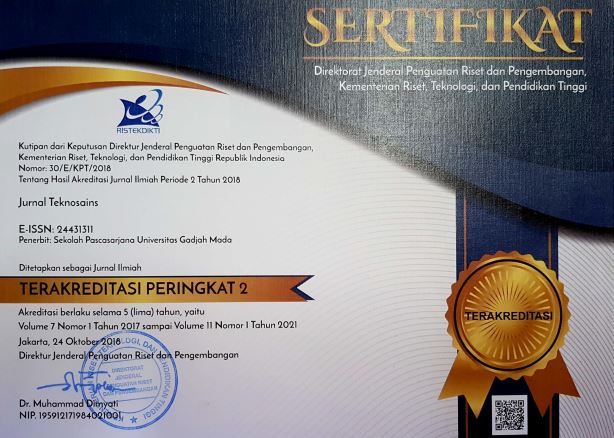Kajian kualitas air dan strategi pengelolaan Rawa Jombor, Klaten, Jawa Tengah
Timotius Ragga Rina(1*), Setyawan Purnama(2), Andhika Puspito Nugroho(3)
(1) Universitas Gadjah Mada
(2) Universitas Gadjah Mada
(3) Universitas Gadjah Mada
(*) Corresponding Author
Abstract
Rawa Jombor is a semiartificial reservoir whose contruction are works for serving the needs of irrigation in the dry season and as a floading control in the rainy season. Rawa Jombor also used for fish farming and floating restaurant by the community. The existence of the cages and floating restaurant can have a negative impact to the aquatic environment due to the disposal of waste and leftover food and metabolism that is deposited at the bottom of the water. This study aims to analyze the water quality, pollution levels and to develop a management strategy of Rawa Jombor. Water quality is measured at 9 sampling point determined by purposive sampling based on the use of Rawa Jombor. Pollution level is analized uses pollution index and the management strategy uses analytical Herarchy Process. The results show that Rawa Jombor has decreased water quality marked by several parameters that do not meet the class III of water quality standards according to Government Regulation No. 82 of 2001. Rawa Jombor is included in the category of mildly polluted in areas without activity, floating restaurant and fish cage for water allotment class I, II, III and IV with an average pollution index ranging from 1,02 to 2,886. To maintain the continuity of the Rawa Jombor, a management strategy with priority on the economic aspects is needed with the development of the Rawa Jombor for sustainable fisheries.
Keywords
Full Text:
PDFReferences
Bahri, S., Ramadhan, F. and Reihannisa, I. 2015. Kualitas Perairan Situ Gintung, Tangerang Selatan. Biogenesis: Jurnal Ilmiah Biologi, 3(1), pp. 16–22. doi: 10.24252/bio.v3i1.561.
Bayram, A., Bayram, A., Önsoy, H., Bulut, V. N., and Akinci, G. 2012. Influences of urban wastewaters on the stream water quality: a case study from Gumushane Province, Turkey. Environmental Monitoring and Assessment, 185(2), 1285–1303. doi:10.1007/s10661-012-2632-y.
Bengtson, D. A. 2015. Aquaculture Carrying Capacity and Water Quality in Indonesian Lakes and Reservoirs - A New Project. Aquacultura Indonesiana, 15(2), pp. 46–50. Available at: http://aquasiana.org/index.php/ai/article/view/25/28.
David, G. S. 2015. Ecological carrying capacity for intensive tilapia (Oreochromis niloticus) cage aquaculture in a large hydroelectrical reservoir in Southeastern Brazil. Aquacultural Engineering. Elsevier B.V., 66, pp. 30–40. doi: 10.1016/j.aquaeng.2015.02.003.
Effendi, H. 2003. Telaah Kualitas Air bagi Pengeloaan Sumber Daya dan Lingkungan Perairan. IPB, Faculty of Fisheries and Marine Science, Aquatic Resources Management. http://repository.ipb.ac.id/handle/123456789/79927
Indrayani, E. 2008. Biomassa Zoobentos, Kandungan Nutrien Sedimen dan Kualitas Air berdasarkan Zonasi di Rawa Jombor, Kabupaten Klaten, jawa Tengah. Tesis. Fakultas Biologi, Universitas Gadjah Mada.
Liu, J.-S., Guo, L.-C., Luo, X.-L., Chen, F.-R., dan Zeng, E. Y. 2014. Impact of anthropogenic activities on urban stream water quality: a case study in Guangzhou, China. Environmental Science and Pollution Research, 21(23), 13412–13419. doi:10.1007/s11356-014-3237-5
Menteri Negara Lingkungan Hidup. 2003. Keputusan Menteri Negara Lingkungan Hidup Nomor 115 Tentang Pedoman Penentuan Status Mutu Air. Jakarta, Indonesia.
Moridi, A. 2019. Dealing with reservoir eutrophication in a trans-boundary river. International Journal of Environmental Science and Technology. Springer Berlin Heidelberg, 16(7), pp. 2951–2960. doi: 10.1007/s13762-018-1775-y.
Nemerow, N. L. 1974. Scientific Stream Pollution Analysis. Washington: Scripta Book Co.
Nobile, A. B., Zanatta, A. S., Brandão, H., Zica, E. O. P., Lima, F. P., Freitas-Souza, D., and Ramos, I. P. 2018. Cage fish farm act as a source of changes in the fish community of a Neotropical reservoir. Aquaculture, 495, 780–785. doi:10.1016/j.aquaculture.2018.06.053
Nurrohman, A. W. 2019. Analisis Daya Tampung Beban Pencemaran Sungai Cimanuk, Jawa Barat. Tesis. Universitas Gadjah Mada.
Pemerintah Republik Indonesia. 2001. Peraturan Pemerintah Republik Indonesia Nomor 82 Tahun 2001 tentang Pengelolaan Kualitas Air dan Pengendalian Pencemaran Air. Jakarta, Indonesia.
Roriz, G. D., Delphino, M. K. de V. C., Gardner, I. A., and Gonçalves, V. S. P. 2017. Characterization of tilapia farming in net cages at a tropical reservoir in Brazil. Aquaculture Reports, 6, 43–48. doi:10.1016/j.aqrep.2017.03.002.
Safitri, L. F., Widyorini, N. and Jati, O. E. 2018. Analisis Kelimpahan Total Bakteri Coliform di Perairan Muara Sungai Sayung, Morosari, Demak. Saintek Perikanan, 14(1), p. 30.
Sawyer, C. N. and McCarty, P. L. 1978. Chemistry for Environmental Engineering. 3rd edn. Tokyo: McGraw-Hill Book Company.
Setyaningsih, U. P. 2011. Dampak Limbah Organik Hasil Aktivitas Keramba terhadap Kualitas Air Waduk Rowo Jombor Desa Krakitan, Kecamatan Bayat, Klaten. Skripsi. Fakultas Geografi, Universitas Gadjah Mada.
Shukla, S., Jain, S. K., Kansal, M. L., & Chandniha, S. K. 2017. Assessment of sedimentation in Pong and Bhakra reservoirs in Himachal Pradesh, India, using geospatial technique. Remote Sensing Applications: Society and Environment, 8, 148–156. doi:10.1016/j.rsase.2017.08.008.
Article Metrics
Refbacks
Copyright (c) 2023 Timotius Ragga Rina, Setyawan Purnama, Andhika Puspito Nugroho

This work is licensed under a Creative Commons Attribution-ShareAlike 4.0 International License.
Copyright © 2024 Jurnal Teknosains Submit an Article Tracking Your Submission
Editorial Policies Publishing System Copyright Notice Site Map Journal History Visitor Statistics Abstracting & Indexing









